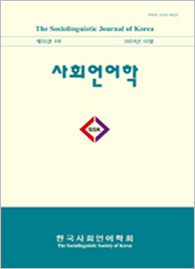![]() Journal Search Engine
Journal Search Engine
ISSN : 1226-4822(Print)
The Sociolinguistic Journal of Korea Vol.32 No.3 pp.97-120
DOI : http://dx.doi.org/10.14353/sjk.2024.32.3.04
DOI : http://dx.doi.org/10.14353/sjk.2024.32.3.04
The Discourse Function of ‘-nuntey’ in Child-Caregiver Interaction
Abstract
From a conversation-analytic perspective, this study examines how the Korean connective ‘-nuntey’ is used in interactions between children and caregivers. The ‘nuntey’-clause occurs not only in utterance-medial positions as a clausal connective but also in utterance-final positions without accompanying main clauses in actual conversations. Previous studies have identified two primary functions of ‘-nuntey’: a ‘background provider’ and a ‘contrast marker’. In this study, the analysis of conversations between children and caregivers shows that caregivers often use the ‘nuntey’-clause to explain why they cannot comply with a child's request or to repremand them for their behavior, which frequently leads to changes in the child’s behavior or intentions. In contrast, children use the ‘nuntey’-clause in "telling-my-side" utterances to describe their own actions or observations, often eliciting responses or praise from caregivers. This pattern refelct the nature of child-caregiver interactions, where the caregiver's primary role is to manage the child’s behavior, while the child’s main goal is to attract the caregiver’s attention.
아동-양육자 간 상호작용에서 사용되는 ‘-는데’의 담화 기능
초록
Vol. 40 No. 4 (2022.12)

Frequency Published four times annually in March, June, September, and December
Doi Prefix 10.14353/sjk.
Year of Launching 1993
Publisher The Sociolinguistic Society of Korea



Online Submission
socioling.jams.or.kr
The Sociolinguistic
Society of Korea
socioling.com
Editorial Office Contact Information
- Tel: +81-10-3894-3164
- E-mail: schang@hoseo.edu






